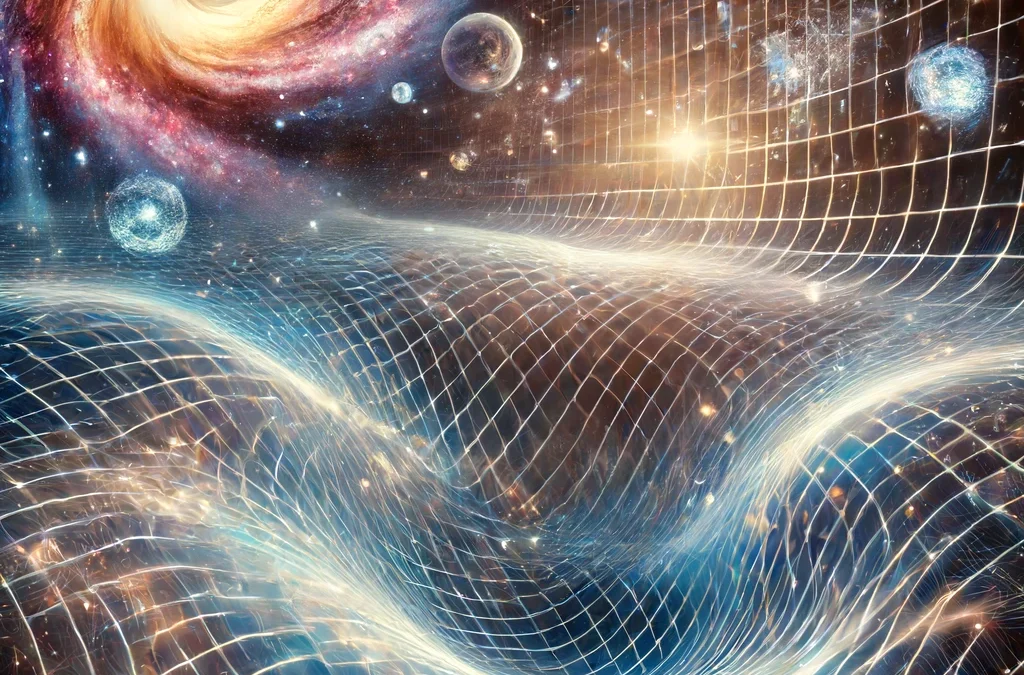Most of modern cosmology rests on a remarkable idea: space and time form a flexible geometry. Mass and energy bend that geometry, and bodies move along its curves. So far, so Einstein. But what if spacetime isn’t just flexible — what if it’s elastic? What if it can store and release “stretch” the way a material can, and send that energy along as waves?
That’s the core of ESET v2.1, our Evolving Spacetime Expansion Theory. It leaves Einstein’s geometric backbone intact and adds one simple ingredient: an elastic response that carries energy and momentum. From that single addition, a lot follows — including clean, testable ways to explain late‑time cosmic acceleration and some of the extra gravity we usually attribute to dark matter
Why add elasticity to spacetime?
A few puzzles keep poking at the edges of our standard picture:
-
Cosmic acceleration: Observations say the universe’s expansion is speeding up. The usual patch is a rigid, ever‑present energy (“dark energy”) built into the vacuum. It works, but it’s an input, not an explanation.
-
Extra gravity: Galaxies and clusters bend light and rotate as if there’s more mass than we can see. The go‑to answer is new particles (“dark matter”). That may be right — but gravity itself could be carrying an extra contribution we haven’t accounted for.
-
Subtle tensions: Different probes sometimes infer slightly different values for the expansion rate or growth of structure. Nothing fatal, but enough to suggest the late‑time universe might be doing something mildly more interesting than a rigid vacuum term.
Elasticity gives spacetime its own dynamical “background state” that can evolve and ripple. Long, coherent elastic states act like a gentle pressure that accelerates expansion. Localized elastic amplitude deepens gravitational wells, behaving dark‑matter‑like — in ways we can measure.
The one‑sentence idea
Spacetime is curved, and it’s also an elastic medium whose deformations carry energy and propagate as waves. Those elastic deformations feed back into gravity, adding a new, testable piece to the cosmic puzzle.
How this stays safe (and sane)
New fields can go wrong fast if they allow negative‑energy excitations (ghosts) or faster‑than‑light signals. ESET v2.1 is built to avoid both:
-
We describe elasticity using a well‑trodden, relativistic “solid” formulation that keeps time evolution healthy and subluminal.
-
The usual gravitational waves — ripples of the spacetime metric — still travel at light speed, exactly as in General Relativity.
-
Total energy–momentum remains conserved, and the standard local tests of gravity are preserved in the relevant limits.
What actually changes in the sky
-
A flexible dark‑energy sector: Instead of a rigid vacuum term, the elastic sector contributes a smooth component whose strength can evolve gently. Late‑time acceleration emerges as a state of spacetime, not a fundamental dial.
-
Patterned “extra gravity”: In regions where elastic amplitude concentrates, gravity deepens slightly, much like adding unseen mass. This shows up in galaxy rotation and gravitational lensing — with specific, subtle patterns.
-
A tiny mismatch in how light bends: Elastic stresses create a small difference between the two gravitational potentials that influence light. Lensing maps can pick up this “gravitational slip.”
-
A new kind of cosmic background hum: Alongside gravitational waves, the universe could host elastic waves. Because they travel more slowly and couple differently, pulsar timing arrays might see frequency‑dependent deviations from the standard correlation curve.
How to look for it
Here’s the short, observer‑friendly checklist:
-
Distances: Fit supernova and BAO data allowing a gently evolving elastic contribution to the expansion.
-
Growth & lensing: Check whether the inferred growth of structure (from galaxy clustering and redshift‑space distortions) and weak‑lensing measurements show the small, coherent patterns elasticity predicts.
-
CMB lensing & late‑time ISW: Compare how much lensing the cosmic microwave background implies with what large‑scale structure expects; elastic stresses nudge this balance.
-
Pulsar timing arrays: Test for small, frequency‑dependent departures from the textbook “Hellings–Downs” correlation — a smoking‑gun signature of subluminal elastic waves.
What would prove us wrong
We’ve made the theory falsifiable on purpose. It fails if:
-
Wide‑field supernova and lensing surveys see no late‑time anisotropy or slip at the predicted sensitivity.
-
Pulsar timing correlations stay exactly on the standard curve across frequencies.
-
A single dark‑matter particle is discovered and shown to explain all gravitational anomalies across scales.
-
Early‑universe data (especially the CMB) rule out the quiet, low‑impact behavior our elastic sector must have had back then.
How this fits (and differs) from other ideas
You can describe many cosmic tweaks as “varying constants.” In ESET, any apparent variation is not fundamental — it emerges from the elastic state of spacetime. Conceptually, that’s cleaner and more predictive. ESET also dovetails with effective field theories of solids and fluids, and it’s adjacent to frameworks with preferred frames (like Einstein–æther), but it keeps the elastic intuition front‑and‑center.
